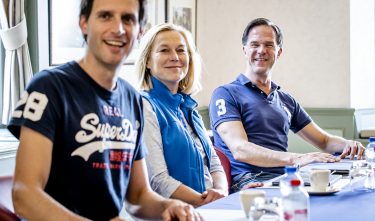In the Dutch Design Awards communication committee, you will see a vast range of images pass by from which the discussion is conducted about what constitutes good or less good design. It is not an easy discussion because, in addition to the image quality, the debate is about the meaning, effect, intention and context or the circumstances in which an image was created.
 1
1
Visual culture is a term that became particularly meaningful when we started swiping and clicking en masse on our smartphones. There came a moment when we saw more images in one day than a medieval person in their entire life. We live in a visual culture driven by media technology. The objects around us became media, and the media became images. At first, only the offices were full of screens, but now we are surrounded by screens everywhere. We see communicating buildings and people who are constantly looking at their smartphones. More clothes are printed than paper, and talking products are getting smarter. The bombardment of visual communication has only just begun. Image has been absorbed into the mass media and is now a means of communication for everyone. And that’s thanks to the cheap and accessible tools such as the super-advanced cameras in your smartphone. Image has become like text. We’ve learned to write with images. The image explosion had and still has enormous consequences for more than we would like.
Humans are not good at keeping pace, and in a consumer society, they constantly struggle with control. In addition to climate, it may soon be the image’s turn for analysis of sustainable development. Could there be such a thing as a free-range statue? An image that has had time to develop? Or to create its own context? Professional images have seen inflation and that abundance means we can no longer see the forest for the trees. Many iconic professions such as graphic design, interior design and fashion have now been automated or marginalized. The disappointed and well-educated designer is now waiting for the visual revolution in which form and image will lead again. In the meantime, our politicians run off with the images and use them since they belong to everyone now. Their performances are directed down to the last detail, and their appearance is styled to win votes. And for today’s ambitious designers, there is no time for images anymore because they are too busy with urgent issues. The climate crisis creates a sober but relevant cultural era.
We definitely won’t abandon the planet if it’s up to the designer. The design world as a whole is diving into the climate crisis. Meetings are being held, and brainstorming is being done about saving the planet according to the design thinking model. Development and maker labs are looming everywhere. There is a lot of experimentation with new insights, materials and innovative ecosystems to start transitions that can improve or even redesign our polluted, abundant and unhealthy living environment. Energy, agriculture, transport, our consumption pattern, housing, production methods, food, clothing, waste, just about all consumables and more have to go through the sustainability mill. Today’s society demands an entirely new design, and that is a responsible task. This may change people’s lives, work and ultimately their thinking. Change is often foretold, sketched and presented as speculative design in the design world. For designers, this is a euphoric experience. Imagine that your idea is going to change the world. That is dreaming, that is freedom, that is power, that is vision, that is passion, that is the ultimate autonomous designer experience.
The presentation of our sustainable message is sober for the time being. Image is out in the design world. We’re seeing the experiments of living organisms such as algae, fungi, plants and bacteria, and these colours are mainly grey, green and brown. If the climate crisis wasn’t bad enough, the designer currently doesn’t get any further than shapeless drabness. The politicians, on the other hand, thrive with their images in the media. They celebrate visual culture and have fun together. They simply push the climate crisis to next year and leave the policy to the designers.
Mieke Gerritzen, chair category Communication